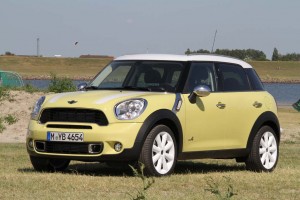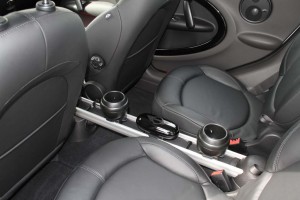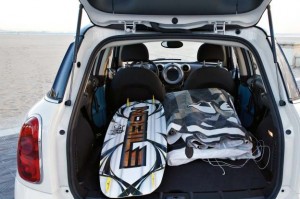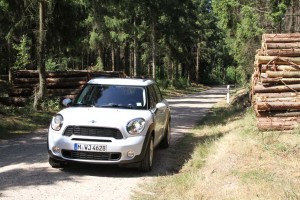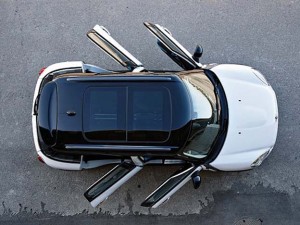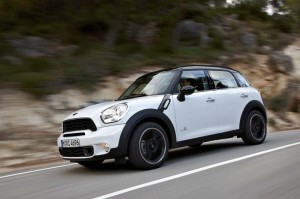Small doesn’t sell – or so went the old automotive axiom. But these days, automotive marketers are singing a different tune. Small is beautiful, and there’s no better example than the Mini.
Since it made its U.S. debut in 2002, BMW’s British brand has handily outperformed expectations. It’s also grown a bit, at least in terms of line-up, with additions like the Mini Open convertible. But is a larger car still capable of being a Mini? Or will the brand max out when the all-new 2011 Countryman rolls into showrooms? That’s a question that sent us scurrying over to Hamburg, Germany to test drive the maker’s latest addition.
Based on an all-new platform, the 2011 Mini Countryman isn’t just larger, it’s also the British marque’s first four-door model. And since we’re talking big changes here, the Countryman is also the brand’s first sport-utility vehicle. No, it’s not about to take on the Jeep Wrangler to see which is more adept at handling rugged courses like the Rubicon Trail, but as we discovered during two days of driving, the new model is reasonably capable on gravel, dirt and deep ruts, especially if equipped with the new Mini ALL4 all-wheel-drive system.
Bigger is a relative term, of course, as we realized as soon as we landed at the Hamburg airport and grabbed the keys to a blinding white Mini Countryman Cooper S ALL4 (whose name is as long as the vehicle itself).
Yes, it’s obviously larger than the little coupe, convertible and hatchback we’ve come to know, but not by nearly as much as one might expect, especially when adding those extra two doors. At 4.1 meters – 161.8 inches for Americans – the Countryman Cooper S is still about 3 inches shorter than the Volkswagen Golf, which is expected to be one of its key competitors.
At 70.4 inches in width, it’s about 4 inches wider, and six inches taller, at 61.5 inches, than the original American version of the Mini Cooper. Meanwhile, the driver sits about a half foot taller in the comfortable and supportive Countryman seat, yielding a Mini interpretation of command seating.
The rear doors open wide and there’s a surprising amount of rear seat room, more than in some notably larger vehicles, like either the BMW 1- or 3-Series offerings.
There’s also a different feel to the interior, we realized after an hour or so behind the wheel. The interior is very much the trademark Mini layout, including the oversized speedometer that caps the center stack – here surrounding a large and easy-to-use full-color navigation display. There’s the more limited digital mph read-out visible between the spokes of the typical Mini steering wheel. There are the classic aircraft-style toggle switches.
About the only distinctly new feature – and a welcome addition – is the center rail – a multi-purpose console stretching front to back to which a variety of storage devices and holders can be attached.
Indeed, there’s really little different about the cabin of the 2011 Mini Countryman except for a surfeit of space.
You just aren’t bumping elbows like you do in a conventional Mini Cooper. Some might decry that seeming lack of intimacy, but it will come as a relief to those who felt the original 2-door was just a wee bit too claustrophobic.
The added dimensions also yield a significant amount of cargo space, something that was also in short supply with the original Mini. The 2011 Countryman will yield 230 liters of cargo capacity, at a minimum, with both of the sliding rear seats in normal position and pulled all the way back. At max, you’ll find room for 1170 liters. That includes a nice little hidden cargo bin below the back luggage floor, which can be left down, folded up or simply removed.
Though decidedly larger, Mini engineers did a surprisingly good job at holding down weight, the Countryman Cooper S ALL4 – with its standard AWD system – tipping the scales at only 539 pounds more than the front-drive Cooper S hatchback.
If there’s a downside to the larger dimensions, you really notice it only during aggressive driving. Wandering down some back roads near the North Sea, we found the Countryman to turn in just like a regular Mini Cooper – in other words, much like a go-kart. But steering was a bit non-linear. In other words, after that nimble first move, it was as if the bulk of the Countryman suddenly caught up with the suspension, introducing some unanticipated body roll and a perceptible softening of the steering.
It’s not something many drivers will even notice, but we were happy to hear senior program managers say they are continuing to tweak suspension settings to find the right balance before launch.
One thing we found difficult to complain about was the Countryman’s 1.6-liter I-4 engine, which makes 184 horsepower and, in the European testing cycle, delivers the equivalent of 39 mpg. We were cautioned that the figure will be slightly lower when the 2012 Mini Countryman is put through the U.S. EPA test process, but it’s still a good range, especially for something that proved so pleasantly peppy.
Mini’s first AWD system is standard on the ALL4 and seems to work as well as one might expect. It hesitated nary a moment when we drove into some deeply-rutted, sandy trails. In routine operation, the system is designed to deliver 100% of torque to the front wheels. If necessary, it can shift “nearly” 100% to the back tires, we were told, though in such circumstances, traction and stability control systems will likely also kick in to reduce engine output.
Meanwhile, the technology begins to phase out as you accelerate above 100 mph. Not that it’s likely to matter to many American drivers, but you’re locked into full front-drive mode once you hit 140 mph.
European buyers, incidentally, will get 16-inch standard tires, but the American edition will be shod in 17-inch Run Flats, with the Cooper S ALL4 bumped up to 18s. (The American edition also gets standard 4 bucket seating, rather than the 5-seater with rear bunch package available in Europe.)
For those who like to think that Mini is one of the last holdouts of the once-great British auto industry, the reality is very different, as was telegraphed during a news conference held along the Hamburg waterfront – in German, since most of the engineering talent for the 2011 Countryman come from BMW – which also lends technology such as an only slightly disguised version of its iDrive to the new model.
And unlike the rest of the Mini brand, which is still produced in Oxford, the new crossover/ute will roll off the Magna Steyr assembly line in Graz, Austria.
Does it matter? Probably not. The look is distinctly Mini, as is the feel – with the exception of that subtle steering issue. Most potential customers will welcome it into the fold. Some may even hail the return of a nameplate once popular in the ‘60s, though the original Countryman was also a two-door, not a Mini take on a sport-utility vehicle.
But for those who like the basic idea of a Mini, and would likely join the fold if it offered something just a wee bit roomier and more practical, well, the 2011 Mini Countryman may be precisely the prescription.

